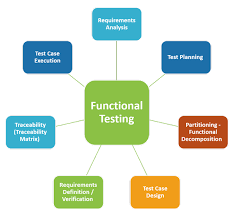What is Functional Testing?
 Software testing life cycle (STLC) is a blend of diverse software testing techniques. However, each of these testing techniques and strategies plays a pivotal function in verifying multifarious qualities, features, and aspects of the software. Functional Testing is one of these testing methods, which assists the elite team extraordinarily in verifying the functionality as well as the quality of the software. As the name suggests, this type of testing assists to check the functionality and quality of the software based on SRS (Software Requirements Specification). One of the key objectives is to validate the functionality of the software and double-check that it is in compliance with the business requirements, stated by the client before the initiation of the project.
Software testing life cycle (STLC) is a blend of diverse software testing techniques. However, each of these testing techniques and strategies plays a pivotal function in verifying multifarious qualities, features, and aspects of the software. Functional Testing is one of these testing methods, which assists the elite team extraordinarily in verifying the functionality as well as the quality of the software. As the name suggests, this type of testing assists to check the functionality and quality of the software based on SRS (Software Requirements Specification). One of the key objectives is to validate the functionality of the software and double-check that it is in compliance with the business requirements, stated by the client before the initiation of the project.
There are six types of tests that can be used to guarantee the quality of the end product. Those tests are functional tests, systems tests, unit tests, system integration tests, regression tests, and acceptance tests. In accordance with the functional specification document, this type of testing is to be carried out. In actual testing, quality consultants or testers need to verify a particular action or function of the code. However, for this kind of testing, either manual tests or automation tools can be used but functionality testing would be further simpler using manual testing only. Prior to Non-functional testing, Functional testing would be implemented first.
Do you want to learn Automation testing?
How Functional Testing Works?
Functional testing is generally performed during the levels of Acceptance Testing and System Testing. Typically, it involves the following steps:
- Identify functions that the software is expected to carry out.
- Generate input data on the basis of the function’s specifications.
- Find out the output of the functions based on the function’s specifications.
- Execution of test cases.
- Evaluate the actual and expected outputs.
It is normally conducted by giving an appropriate input to the function being tested and then evaluating the result by comparing it to the expected outcome. This type of testing can answer queries about the software application’s capabilities, for instance, what actions users are able to perform.
Techniques Used for Functional Testing
During the functional testing process, two foremost techniques are used by the team of testers. Each of these caters to special and distinct aspects of the software and work together to improve the performance and quality of the software. These techniques are:
- Requirements-focused testing– Prioritizes requirements based on a threat to assess the most critical and significant functions and features first.
- Business-process-focused testing– Relies on knowledge of end-user business necessities to estimate an application’s performance in the context of distinctive use cases.
Apart from these two extraordinary methods, functional testing also uses the black box testing and white box testing techniques for running the tests and to make sure the quality, functionality as well as the performance of the software product.
Bottom line
From the above explanation, we can easily conclude that to build up a robust foundation of a superior class software product, this type of testing is crucial. It acts as the rock layer of the structure and is an essential part of each test routine.


